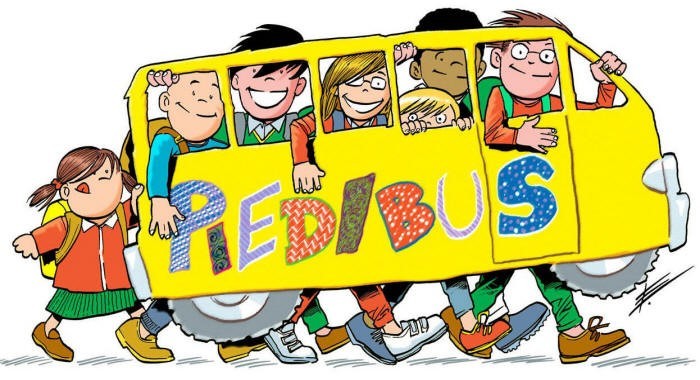Near my home in Rome is an unusual sort of bus stop. The sign says Piedibus and shows a children’s drawing of a foot-propelled school bus. A Piedibus or walking bus, has all the elements of a school bus – children, driver, a fixed route with pick-up and drop-off times – but no bus. In high-density areas with compact school catchment areas, it turns out that the least essential element of a school bus is the bus.
Thanks to the COVID crisis, all of our work as facilitators has either gone virtual or gone away. We find ourselves in a forced experiment to discover which seemingly-essential element of our work turns out to be expendable, and which element we mustn’t forego if our work is to maintain its essence and its raison d’être. How can we be certain we’re not just simulating collaboration?
The purpose of a school bus is to get children to school, safely and predictably. The purpose of facilitation is to enable people with different ideas and experiences to discover what they share and then to act on that discovery in concert. If the tangible artefact of the school bus – the bus – is expendable, can we dispense with the most tangible artefact of facilitation – the workshop? As we trade the front of the room for the front end of Zoom, we are just beginning to discover what we can and can’t do without. Above all, when we move beyond ‘presence’ and escape the bounds of time and space (which is the greatest promise of virtual facilitation), what do we gain and what do we lose?
Regardless of our pre-COVID experience of virtual facilitation, I think we have all been learning how much more we can get out of virtual events (and how much more we have to put into them!) than we ever imagined. Yet I keep thinking that, like a dog walking on his hind legs: he doesn’t do it very well, but it’s remarkable that he can do it at all. Quite simply, we are pleased with how well our virtual convenings are working because we had not expected them to work at all. Instead, we do get insights, but no breakthroughs; alignment, but no belief; participation, but precious little collaboration; a shared experience, but no magic. Like sexting, it can spice up an existing relationship but is certainly can’t replace IRL.
We are collaborating with a large consulting firm preparing for a major project. I asked them about adapting our approach for the coming weeks and months, when physical convenings will be out of the question. Their reply was, “So far, it seems we have been able to seamlessly pivot to complete virtual delivery of our work. The projects are going forward at the same pace with only a few exceptions.” This suggests that the measure of success is pace. I think we should aim higher.
If we don’t lose ‘pace’ in a virtual event, what do we lose? What is missing from the experience and what is missing from the result? We have Zoom ice-breakers and energizers, intimate break-out groups, and instant-feedback voting, but the morphing mosaic of mug-shots and grey, named rectangles is as desolate as a ghost-town populated by the shades of our friends and colleagues. It is the difference between the casual energy and serendipity of strolling down a busy street and the desolation of waving to our masked neighbours from across a courtyard.
As for results, we know how to Zoom-facilitate a team towards something resembling consensus and even summon the energy to keep that consensus alive in the weeks following an event. (The jury is still out for long-term commitment.) But facilitating a solution to our client’s challenge was always a pretence, a cover-story for our true vocation of changing people’s lives, or at least their jobs, in the matter of a few long days.
I have just come off a de-brief call with a client for whom my team facilitated a virtual retreat last week. The retreat was meant to be a three-day face-to-face alignment and planning exercise. We translated it into three half-day Zoom sessions facilitated by our team of three. The client is over the moon and I am beaming with pride for my team. The client even used the word ‘magic’ to describe the impact on the other participants.
Making use of what Zoom can do, we can supplement our face-to-face work, stretching out the interactions before and after an in-person event to supplement the engagement. We can mix our brief, highly-intense interactions with frequent, lower-intensity learning, building, comparing, tracking and sensemaking. We can flatten the interactive curve – extending it in time while maintaining a few peaks of deeply-collaborative work with everyone in the same place at the same time.
So what am I worried about? We can do effective work in a virtual space. We can achieve tangible results. But I only have to look at a photo of an event conducted with presence – at the same time and in the same space – to remember the importance of focus, of physical proximity, of the attention we pay to each other, of the control we graciously relinquish when we step into the same room as other people without the option of switching off our camera, of the energy we create when we all want to speak at once – and do!
And what about the relationships we create while sharing an experience? On-line meetings can sustain existing relationships; creating new, meaningful ones on Zoom is another matter.
This photo was taken 62 days ago in my now-shuttered office in Rome. A relic from a bygone age depicting a scene that is unthinkable today.
The first definition of ‘virtually’ is ‘almost’. If we’re ‘virtually there’ it means that we’re not there yet. The Piedibus works fine without a bus because the children are together – at the same time and in the same place. Presence can be simulated on-line, but it can’t be replaced. Once in a while, we too need to be together at the same time and at the same place.
– Dan Newman, Matter Group
Dan is the author of From The Front of the Room: Notes on Facilitation for Experienced Practitioners (only available on Kindle until the COVID crisis passes).


